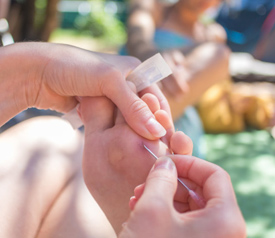
Swimming is a popular activity for people of all ages. Whether swimming in a pool or swimming in a body of water, those with healing wounds need to be careful when exposing their wounds to the water. Low-quality bandages and improper seals can cause major issues for a healing wound.
Exposing a wound to water, especially through swimming, can cause a wound to reopen, slowing the healing process. It can also expose the wound to bacteria in the water, leading to an infection. Even in clean pools with chlorine, a wound can take on damage from these chemicals.
In addition to the initial healing of the wound being slowed, permanent damage can occur. Skin needs time to heal after a wound forms, and when a wound doesn’t get a chance to heal properly, the skin can be damaged for good, leading to thinner skin and easier opening down the line.
Things to consider before swimming
There are a few factors that any swimmer should think about before they get back in the pool after a wound injury. Consider these factors before diving in:
- How long has it been since the wound occurred? – The more recent a wound occurred, the most susceptible it will be to damage. Consult a doctor to better understand how long you should wait for your type of wound to heal before swimming.
- What type of water will you be swimming in? – Both clean pools and natural bodies of water pose threats to open wounds. Pools feature chemicals that can irritate or damage a wound while natural bodies of water can feature bacteria that can lead to infection.
- How long will you be in the water? – Naturally, the less time a wound is exposed to the water, the better. Think about how long you intend to be in the water for a swim.
These are just a few things to think about before engaging in swimming with a fresh wound. No matter your situation, always be sure to dress the wound properly.
How to dress a wound for swimming
It’s very important to properly dress a wound before swimming. With the wrong dressing or application of a dressing, water can seep in and cause major damage.
Experts recommend ensuring a bit of airflow be available for a wound at all times. Covering a fresh wound and applying too much pressure can cause it to reopen and slow the healing process.
Absorbent wound dressings are always a bad idea for swimming. The water will soak the wound dressing and therefore soak the wound itself underneath.
The best option for covering a wound for swimming is to use a waterproof plaster. These specially-designed bandages cover the wound area in full and provide a tight tape seal around the edges. This can help ensure that water does not penetrate the seal and the wound stays dry and covered.
Waterproof plasters are also designed to keep chemicals out of the wound. This can be especially helpful when swimming in a pool that features chlorine and other cleaning agents. These chemicals can irritate the weakened skin and slow the healing process.
Sealing a wound dressing for swimming
While wound plasters offer a great deal of protection against water, it’s vital that they stay sealed in place. It’s best to use Hy-Tape to ensure a tight seal over the edges of a plaster.
Hy-Tape is made for waterproofing. It holds tightly to the skin but also provides for easy removal afterward. The zinc-oxide formula used in Hy-Tape is also designed to help avoid skin irritation. Some wound dressings feature tapes that can cause skin issues, but Hy-Tape contains no skin irritants.
Before you return to swimming after obtaining a wound, make sure you cover the wound with the right dressing and seal it off with Hy-Tape. Keeping a waterproof seal around your wound dressing will help keep water, bacteria, chemicals, and more away from the wound.
The less irritation your wound experiences while swimming, the better. Talk to your doctor about the best wound dressing options for your specific type of wound.
Be sure to seal your wound dressing with Hy-Tape to ensure a waterproof seal and little to no skin irritation. Learn more about Hy-Tape by reading our other articles.
- Waterproofing Your Wound Dressing for Swimming
- Swimming and Staying Active with an Ostomy
- Wound Dressing & Ostomy Summer Sweat & Waterproofing Resources
- Wounds & Exercise – The Healing Benefits of Activity
- I tested Hy-Tape on my Kids During a Heat Wave
- A Summer with Wounds and Scars Can Still Be Fun
- Securing & Waterproofing for Summer Splashes – A Mom’s Testimonial

